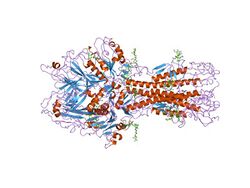Biology:Haemagglutinin-esterase fusion glycoprotein
| Hemagglutinin domain of haemagglutinin-esterase-fusion glycoprotein | |||||||||
|---|---|---|---|---|---|---|---|---|---|
 x-ray structure of the haemagglutinin-esterase-fusion glycoprotein of influenza c virus | |||||||||
| Identifiers | |||||||||
| Symbol | Hema_HEFG | ||||||||
| Pfam | PF02710 | ||||||||
| InterPro | IPR003860 | ||||||||
| SCOP2 | 1flc / SCOPe / SUPFAM | ||||||||
| |||||||||
In molecular biology, haemagglutinin-esterase fusion glycoprotein (HEF) is a multi-functional protein embedded in the viral envelope of several viruses, including influenza C virus, influenza D virus, coronaviruses, and toroviruses.[1][2] HEF is required for infectivity, and functions to recognise the host cell surface receptor, to fuse the viral and host cell membranes, and to destroy the receptor upon host cell infection. The haemagglutinin region of HEF is responsible for receptor recognition and membrane fusion, and bears a strong resemblance to the sialic acid-binding haemagglutinin found in influenza A and B viruses, except that it binds 9-O-acetylsialic acid. The esterase region of HEF is responsible for the destruction of the receptor, an action that is carried out by neuraminidase in influenza A and B viruses. The esterase domain is similar in structure to Streptomyces scabies esterase, and to acetylhydrolase, thioesterase I and rhamnogalacturonan acetylesterase.
The haemagglutinin-esterase glycoprotein HEF must be cleaved by the host's trypsin-like proteases to produce two peptides (HEF1 and HEF2) in order for the virus to be infectious. Once HEF is cleaved, the newly exposed N-terminal of the HEF2 peptide then acts to fuse the viral envelope to the cellular membrane of the host cell, which allows the virus to infect the host cell.
The haemagglutinin-esterase glycoprotein is a trimer, where each monomer is composed of three domains: an elongated stem active in membrane fusion, an esterase domain, and a receptor-binding domain, where the stem and receptor-binding domains together resemble influenza A virus haemagglutinin. Two of these domains are composed of non-contiguous sequence: the receptor-binding haemagglutinin domain is inserted into a surface loop of the esterase domain, and the esterase domain is inserted into a surface loop of the haemagglutinin stem.
References
- ↑ de Groot RJ (February 2006). "Structure, function and evolution of the hemagglutinin-esterase proteins of corona- and toroviruses". Glycoconj. J. 23 (1–2): 59–72. doi:10.1007/s10719-006-5438-8. PMID 16575523.
- ↑ "Structure of the haemagglutinin-esterase-fusion glycoprotein of influenza C virus". Nature 396 (6706): 92–6. November 1998. doi:10.1038/23974. PMID 9817207.

